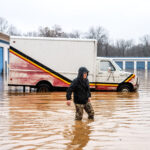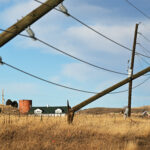Rain continued falling on much of New Hampshire late Wednesday, keeping some schools closed and lengthening the morning commute for drivers detouring around washed-out roads.
Thousands of homes and businesses still had no power, and the state’s largest utility, Public Service Company of New Hampshire, warned that customers in remote areas of the North Country and the western part of the state might not get power back until the weekend.
In the Raymond-Auburn area, residents said it might be two weeks before full phone service was restored, after Verizon’s central switching station in Raymond was flooded. People can call within their own exchange, but cannot call numbers outside the local area _ or reach 911, residents said Wednesday.
Gov. John Lynch, who toured flood-damaged Goffstown and New Boston on Tuesday, has asked the Federal Emergency Management Agency to start a preliminary damage assessment in all 10 counties to determine the state’s eligibility for federal disaster relief.
“Many New Hampshire communities have been overwhelmed by all the flooding,” he said.
In the Legislature, the sponsor of a bill that would send $3.7 million to communities affected by last year’s mid-May floods said it should be changed to cover this week’s flooding as well.
Sen. Ted Gatsas, R-Manchester, said a House committee planned a hearing on the bill Wednesday, but he hoped the chamber would delay action and amend the bill once the state completes damage assessments from the latest flooding.
“If the towns that were hit this week are declared a disaster and FEMA comes in and makes the same allocations it did on the last two floods, then there’s no question that we should be doing the same thing for these communities,” he told the New Hampshire Union Leader.
The New Hampshire National Guard rescued 18 children and school staff after the road to the Nottingham School was cut off in several places by flooding from the North River, said town emergency manager Paul Colby. The 157th Air Refueling Wing used two 5-ton trucks to ford the flood waters and carry the children to pickup points where their parents could meet them, he said.
The children were never in danger, but it was no longer safe for their parents’ cars or school buses to travel on Route 152, he said.
“The school had full power, heat, running water, plenty of food,” he said. “You should have seen the look on some of these kids’ faces when they said, ‘I got a ride home in an Army truck.”’
In Goffstown, Lynch met with residents such as Nancy Congdon, who rebuilt her home to sit higher after it suffered flood damage last May. The work wasn’t even finished yet; the Piscataquog River had flooded her home again.
“You don’t expect a 100-year flood again, 11 months and two days from last year. Once in a lifetime is more than enough,” she told WMUR-TV. “I don’t know if I can financially afford to stay,” Congdon said.
In Allenstown, four people were taken into custody after they did not follow a mandatory evacuation Monday night. Some of them, including a man who returned to retrieve his pet parrot, became trapped and called for help.
Evelyn Bernard, one of those who was handcuffed and fingerprinted, said she and her husband were told to evacuate several times. They said when they were getting ready to leave, a police officer came up in a boat, and she was arrested.
“The only thing I’ve ever gotten before is a speeding ticket,” she told WMUR.
Kelley Collins, a spokeswoman for the town, said she felt bad that people were arrested, but they were given plenty of time to evacuate. “It was her safety that was at risk and all the first responders that were out there risking their lives to take care of our citizens.”
At the storm’s peak Monday, utilities reported roughly 90,000 outages statewide. Fewer than 30,000 homes and businesses were without power Wednesday, including 10,500 customers of Public Service Company of New Hampshire.
The utilities said repairs were going slowly because of the large number of small problems needing attention, continued flooding and impassable roads.
In nearby Maine, the storm with gusts topping 80 mph and rainfall topping 7 inches felled utility poles, knocked over trees and created raging floodwaters.
Cleanup was hampered by the fact that many roads and bridges were out, said Steve Harding of the York County Emergency Management Agency.
In York, snowplows were used to remove boulders and other debris that washed onto U.S. Route 1A. In Portland, a crane was ordered to salvage three boats that sank at DiMillo’s Marina.
Tens of thousands of Mainers were still in the dark Tuesday, and they were warned that it could be days before electricity was fully restored.
In York County, it was the second year in a row in which Mother Nature hammered vacation spots, particularly the storm-prone Camp Ellis section of Saco, Kennebunk Beach and the coastal areas of York. Destruction from a Mother’s Day storm in 2006 left tourist businesses at York Beach scrambling to get ready for the summer season.
At York Beach, seaweed littered the sidewalks and a large Coast Guard bell buoy lay on the beach, ripped from its mooring. The ocean surge on Monday turned the village’s streets into rivers and filled a parking lot with sand.
“We’re used to this by now,” said Joe Lipton, owner of Inn on the Blues. “We just say, ‘Bring it on.’ There’s nothing you can do.”
Harvey Reid of York watched in awe as huge waves crashed ashore. The storm reminded him of the one in 1991 that formed the basis of the book, “The Perfect Storm.” “But the ‘perfect storm’ was nothing compared to this,” he said.
As of Tuesday afternoon, Central Maine Power was still trying to sort out problems with its main trunk lines, and the Maine Department of Transportation was assessing washed out roads and bridges, Harding said.
“They’re trying to figure out a way to get their infrastructure back together so they can begin doing repairs,” he said.
The problems in York County caused the cancellation of service by Amtrak’s Downeaster, which runs from Portland to Boston, for a second day on Tuesday. Part of the track was washed out, and workers were attempting to make repairs so service could resume Wednesday.
Central Maine Power, which was dealing with the largest number of power outages since the ice storm of 1998, still had 71,000 homes and businesses without service Tuesday, while Bangor Hydro Electric reported about 2,100. The totals showed that utility crews were making progress.
Meanwhile, emergency officials warned people to stay away from downed power lines and not to attempt to cross flooded roads.
During the height of the storm’s fury, a Lebanon woman and her 4-year-old granddaughter died as they tried to cross a washed-out section of road to get to the woman’s home, the Maine Warden Service reported.
Donna Dube, 50, and Saphire Perro of Manchester, N.H., were pulled from the Little River and were pronounced dead at a Sanford hospital.
“If you see water on the roads, turn around and go back,” Harding said. “We had a fatality … and we don’t want to see that happen again.”
Gov. John Baldacci, speaking at Maine Emergency Management Agency headquarters in Augusta, said recovery from what he called Maine’s worst natural disaster since the 1998 ice storm has begun but will be a long-term process.
The state of emergency will continue for at least a few more days and extra line crews have been brought in from Canada to help restore power, Baldacci said. He said he has been in touch with federal officials about additional help.
Appealing for patience, the governor said, “It will take time to assess, plan and recover.”
“We don’t want any more fatalities. We want people to watch out for each other, that’s a true Maine tradition to look out for each other, and lend a hand to a neighbor, make sure you’re calling on seniors. In a lot of cases people aren’t leaving their homes and they wait until it’s too late. I don’t want that to happen,” he said.
Was this article valuable?
Here are more articles you may enjoy.

 Flooding in California Leads to Soaked Roads, Water Rescues and 1 Death
Flooding in California Leads to Soaked Roads, Water Rescues and 1 Death  Cat Bonds Linked to Wildfires Lose ‘Once Untouchable’ Status
Cat Bonds Linked to Wildfires Lose ‘Once Untouchable’ Status  Insurance AI Demo Day Calendar Announced
Insurance AI Demo Day Calendar Announced  Rare Weather Warning Issued as Strong Gusts Fuel Colorado Wildfire Threats
Rare Weather Warning Issued as Strong Gusts Fuel Colorado Wildfire Threats 